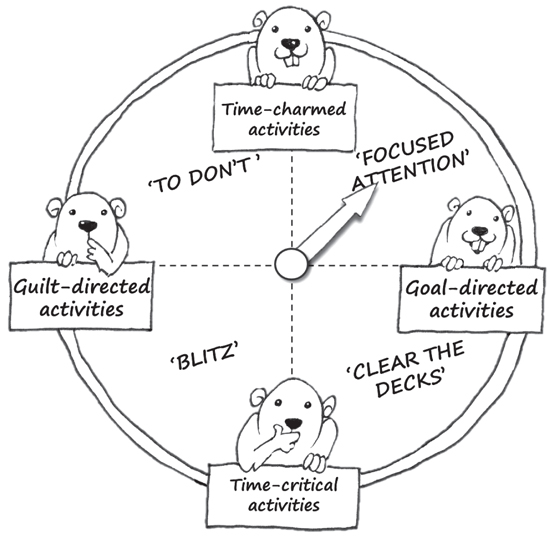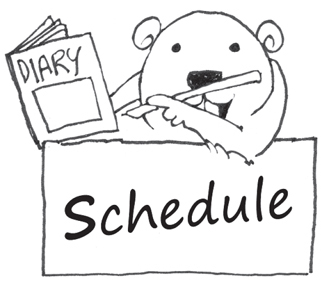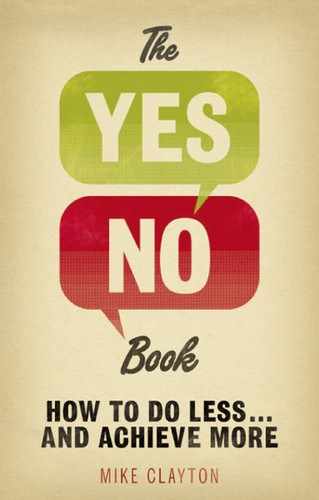CHAPTER 8
The Yes/No Compass
As we near the end of The Yes/No Book, it’s time to put much of what we have learned into a simple framework. This is ‘The Yes/No Compass’, which will help you chart your direction through life’s Yes/No decisions, so you can use your time to your very best advantage. We will look at the four directions on the compass and take a particular interest in the special direction of focused attention.
Finding your direction
In Chapter 3, we met the distinction between goal-directed and guilt-directed activities, and saw that goal-directed activities are the ones to say ‘YES’ to. These are the things you either must do – so you may as well do them with spirit – or the things you want to do, because they take you towards your goals.
Guilt-directed activities, however, are driven by a sense of ‘should’ or ‘ought’. These are the things you do for other people and through a duty to which you are no longer fully committed. We do them out of fear of the consequences of not doing them rather than out of a true passion and commitment to get them done.
In Chapter 7, we distinguished between time-critical and time-charmed activities. Time-critical activities set their own deadline – you have no choice when to do them and therefore you need to tackle them now. Time-charmed activities allow you to be in charge, and choose when you do them. The best time is rarely now.
We can plot all four types of activity on a single chart, to produce the Yes/No Compass.
On this compass, you can see that the lower half is characterised by time-critical activities – it represents ‘Now’. The upper half represents ‘Not now’. To the right, we have goal-directed activities, to which we will want to say ‘YES’. To the left, are the activities we would prefer to say ‘NO’ to.
Some activities will not lie on this compass:
- time-expired activities that are no longer of value
- displacement-directed activities that never would have a value because they are about wasting your time
- desire-directed activities that are purely about taking pleasure in the moment.

None of these requires a decision. As soon as you think about them, the first two will instantly strike you as deserving a ‘no’. If your activity is truly desire-directed, you will have made up your mind already: it’s a ‘YES’.
Any other activities will lie somewhere else on the compass. They will be partly goal-directed and partly guilt-directed. And they will be somewhat time-critical and somewhat time-charmed. Between the four cardinal directions are four regions. Each has a principal strategy for activities that lie in the zone. Let’s examine these one at a time, moving around the compass as we go.
Focused attention
The direction of ‘focused attention’ is the special direction. In this direction are activities that will make a real difference, and for which you have the time to plan how you tackle them. You can do them well, efficiently, and at the right time. When you do choose to do them, you can give these tasks focused attention that will allow you to enjoy the process – perhaps getting into a flow state – and complete them to the quality standard that you choose.
The sorts of activities that will attract this focused attention include creative tasks and inventing new ideas, pursuing the opportunities to transform your work or your life, following your passions and moving towards your goals, building and maintaining the relationships that matter to you, and planning and preparing for the next important project.
Clear the decks
You must make time to deal with pressing priorities that are goal-directed and time-critical. Set everything else aside and ‘clear the decks’, because these activities are usually needed to meet the deadlines attached to essential projects or are crises that emerge in important parts of your work or life. You have no choice but to tackle them and no option but to do it now. You must be flexible and recognise that all your other ‘focused attention’ activities will need to get pushed back, and may themselves become ‘clear the decks’ activities if the delay is too great.
How do you keep the amount of time you spend in this region to a minimum? The answer is to ensure that you use your focused attention time well, to ensure that all of your deadline-driven activities are scheduled and are completed well ahead of the deadline. This way only problems and crises that are truly outside of your control will emerge here. As you get better at navigating with your Yes/No Compass, you will find ways to extend your zone of control outwards to help the people around you manage their deadlines and hence reduce the number of crises you need to become involved in.
Blitz
I know that the region labelled ‘blitz’ lies on the ‘NO’ half of the compass. These are time-critical, guilt-driven activities. However, the time-criticality means that often you won’t be able to say ‘NO’ effectively – it will be too late. These sorts of interruptions and ritual activities, like attending a meeting here and answering an e-mail there, can’t always easily be turned down without triggering a lot of guilt or fear of the consequences, which substantially outweigh the scope of the task. Sometimes, it is just better to get on and do it.
But do it as quickly and efficiently as possible. Do it to the minimum acceptable standard and give it the minimum time possible. A good way to tackle the little admin-type tasks that accumulate is to blitz them. Set aside a fixed amount of time in your week, or day – say 30 minutes. Make it your mission to get through as many of these tasks as you can in that time. Start with the most pressing and valuable tasks and work on them quickly and with real focus. You will be amazed how much you can do in that half an hour.
For some people it really helps to put on fast music in the background – but it won’t work in a shared work space. You may also find that promising yourself a small reward at the end, if you can get it all done, will help. If you are a competitive person, you can set targets and stretch targets for how many things you can clear in your 30 minutes, or for how soon you can finish everything within the maximum time you have allowed yourself.
To Don’t
You might feel boxed into a corner with time-critical, guilt-directed activities, but when your activities are guilt-directed and time-charmed, without any deadline, you have plenty of time to take control, and put them in your ‘To Don’t’ pile. The concept is simple, most of us have a To Do list of things we intend to do sometime, so why not create a list or a pile of things you intend to not do?
TO DON’T EXERCISE
Go through your To Do list now. Look for any item that is neither time-critical nor goal-directed. I know that you feel you should do these things but how much difference will they really make? I bet some of them have been hanging around on your To Do list for weeks – maybe longer.
Start a new list. Label the top of a sheet of paper ‘To Don’t’ and transfer these ‘ought to’, ‘should’ and ‘maybe’ tasks on to your To Don’t list and cross them off your To Do list. Well done. You’ve now cleared down a number of To Do items quickly and efficiently. You will feel a lot less stressed by these items, which only served to keep you feeling guilty that you hadn’t done them. They drained you of mental and emotional energy without offering significant opportunities to make your life better.
Now, what to do with your To Don’t list? If you are feeling really brave, then screw it up and file it in the little round filing cabinet on the floor, by the door. If you are less courageous and are concerned, you may want to refer to it in a week or two (you won’t), then file it in a drawer somewhere. Here, it will be safe, but make sure it isn’t a drawer you use often as otherwise, these To Don’t items will continue to nag you unnecessarily.
Sometimes you will struggle over whether or not to transfer an item to your To Don’t list. The test is simple. If you really don’t want to transfer it (but know somehow that you should), are you prepared to take one small step towards completing this task today? If not, transfer it. The worst that can happen is, someday, this task will pop back into your consciousness. You know what? That means it may be time. Then will be the time to put it on your new To Do list and schedule it for some focused time.
Planning for YES
The master process for planning your time is the ‘OATS process’. This is a powerful principle, based on human psychology and the established disciplines of successful project management.
You can do your OATS planning on a daily, weekly, fortnightly or monthly basis. It has only four steps to it.

Outcome

Start off by thinking what outcome or outcomes you would like for the day, week, fortnight or month ahead. What do you want to be different by the end, compared to how things are now? Outcomes should describe meaningful changes that have value to you or to other people. They may take you towards one of your goals or make a contribution to something you have committed to.
Outcomes are worthwhile, and therefore motivating. To give your motivation a further boost, ask yourself:
‘What will it mean to me when I achieve this outcome?’
Activities

Next, for each outcome you have set, list all of the activities you need to carry out to achieve the outcome. This may seem like little more than a To Do list, but it is a highly focused To Do list, where every single activity is clearly goal-directed.
Time

The trickiest part of the OATS process is estimating the time that each activity will take. The more you practise this, however, the better you will get at it. The best way to estimate is on the basis of experience – yours if you have it, other people’s if you don’t. And remember that we are all prone to underestimate how long things will take us to do, so always add plenty of contingency time for underestimates and problems. If you can get a second opinion from someone else on big and important tasks, this would be wise. Not only will their estimate implicitly check your assumptions, but when both of you understand the task equally, you will find that people are more realistic about others’ time and efficiency than we are about our own.
Schedule

The most important step of all is to schedule your tasks into your day, your week, your fortnight or your month. The commonest reason why things don’t get done is because something else crowds them out. If you have scheduled a particular time-slot to do it, then when someone asks you to help with something else, it is easy to look them in the eye and say:
‘No. I’d like to help, but I have another commitment.’
Choose a time to schedule each activity that will allow you to give it the focus and care it needs, and to do it as effectively as possible, using the principle of purposive procrastination that you read about in Chapter 7.
Yes/No in an instant
Use the Yes/No Compass to decide what strategy to apply to any activity. For tasks that merit the all-important ‘focused attention’, use your OATS process to plan them into your day, week, fortnight or month.
| Yes/No: | Does it require focused attention? |
| Yes/No: | Have you demoted some of your To Do tasks to your new To Don’t list yet? |
| Yes/No: | Have you decided when you are going to make your OATS plan? |
| Yes/No: | Are you ready to say NO? |
